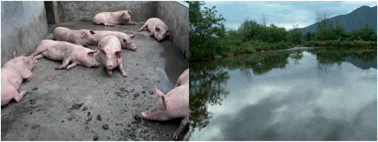There has been recent concern that antibiotics in the environment may increase bacterial resistance, potentially having consequences on their efficacy. The use of antibiotics on livestock has greatly increased in recent years, estimated by over 50% between 2007 and 2010, resulting in a proportional increase in the amount excreted into wastewater as active compounds.

Ben et al. surveyed 41 swine wastewaters from 21 concentrated animal feeding operation sites in the Shandong Province, China, in both the summer and winter. The group targeted 5 sulfonamides, 3 tetracyclines and a macrolide analysing both the liquid and solid fractions of the wastewater. The sample preparation in brief included ultrasonication (for the solid samples) and Solid Phase Extraction (SPE) followed by LC-MS.
Results in brief showed that all antibiotics, apart from one, were found at concentrations which were largely comparable to other data within this field, although occasionally up to 2.02 mg L-1, with concentrations generally higher during the winter. The concentrations of antibiotics added to food was proportional to the size of the site, whereas those given at times of disease were much more variable. Partitioning coefficients for each antibiotic were calculated and reported; the antibiotics were largely present in the liquid, although significant proportions were adsorbed to solid matrices, with adsorption vary between seasons.
This paper would be of interest to anyone interested in antibiotic resistance, analytical techniques to detect antibiotics and agricultural practices with regard to antibiotic use. You can download the paper here, free for the next 4 weeks*.
Occurrence and partition of antibiotics in the liquid and solid phases of swine wastewater from concentrated animal feeding operations in Shandong Province, China
Weiwei Ben , Xun Pan and Zhimin Qiang
DOI: 10.1039/C3EM30845F
*Free access to individuals is provided through an RSC Publishing personal account. Registration is quick, free and simple










